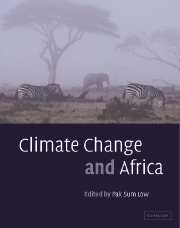Book contents
- Frontmatter
- Contents
- Notes on contributors
- Peer reviewers
- Editor's note
- Foreword
- Foreword
- Foreword
- Foreword
- Preface
- Preface
- Preface
- Preface
- List of abbreviations
- List of SI prefixes
- List of unit abbreviations
- List of chemical formulae
- Part I Science
- Part II Sustainable energy development, mitigation and policy
- 10 Biomass energy in sub-Saharan Africa
- 11 Natural resources: population growth and sustainable development in Africa
- 12 Sustainable energy development and the Clean Development Mechanism: African priorities
- 13 Opportunities for clean energy in the SADC under the UNFCCC: the case for the electricity and transport sectors
- 14 Regional approaches to global climate change policy in sub-Saharan Africa
- 15 Energy for development: solar home systems in Africa and global carbon emissions
- 16 Climate change in sub-Saharan Africa: assumptions, realities and future investments
- 17 Climate-friendly energy policies for Egypt's sustainable development
- Part III Vulnerability and adaptation
- Part IV Capacity-building
- Part V Lessons from the Montreal Protocol
- Index
12 - Sustainable energy development and the Clean Development Mechanism: African priorities
Published online by Cambridge University Press: 10 December 2009
- Frontmatter
- Contents
- Notes on contributors
- Peer reviewers
- Editor's note
- Foreword
- Foreword
- Foreword
- Foreword
- Preface
- Preface
- Preface
- Preface
- List of abbreviations
- List of SI prefixes
- List of unit abbreviations
- List of chemical formulae
- Part I Science
- Part II Sustainable energy development, mitigation and policy
- 10 Biomass energy in sub-Saharan Africa
- 11 Natural resources: population growth and sustainable development in Africa
- 12 Sustainable energy development and the Clean Development Mechanism: African priorities
- 13 Opportunities for clean energy in the SADC under the UNFCCC: the case for the electricity and transport sectors
- 14 Regional approaches to global climate change policy in sub-Saharan Africa
- 15 Energy for development: solar home systems in Africa and global carbon emissions
- 16 Climate change in sub-Saharan Africa: assumptions, realities and future investments
- 17 Climate-friendly energy policies for Egypt's sustainable development
- Part III Vulnerability and adaptation
- Part IV Capacity-building
- Part V Lessons from the Montreal Protocol
- Index
Summary
Keywords
Africa; energy; climate change; Clean Development Mechanism; sustainable development; technology transfer; capacity-building
Abstarct
The Kyoto Protocol to the United Nations Framework Convention on Climate Change (UNFCCC) created a new possibility for North-South cooperation in mitigating climate change through joint projects under the Clean Development Mechanism (CDM). Much work remains to be done to clarify whether and how the CDM can meet its dual goals of contributing to sustainable development in developing countries and assisting industrialized countries meeting their commitments to emissions reduction and limitation. The purpose of this chapter is to highlight some key issues related to the development of the CDM from the perspective of African energy development, and to discuss options for addressing those issues. We begin by reviewing some key indicators of energy in Africa. We then discuss five areas within the negotiations where the design of the CDM and associated institutions can contribute to sustainable energy development in Africa: broadening the scope of CDM projects to include regional projects and institutional development; operationalizing sustainable development in project selection criteria; promoting technology transfer; ensuring a fair distribution of credits and other benefits from CDM projects; and building capacity to both implement projects and formulate enabling policy for the CDM.
INTRODUCTION
The Kyoto Protocol to the United Nations Framework Convention on Climate Change (UNFCCC) created a new possibility for North-South cooperation in mitigating climate change through joint projects.
- Type
- Chapter
- Information
- Climate Change and Africa , pp. 124 - 135Publisher: Cambridge University PressPrint publication year: 2005



